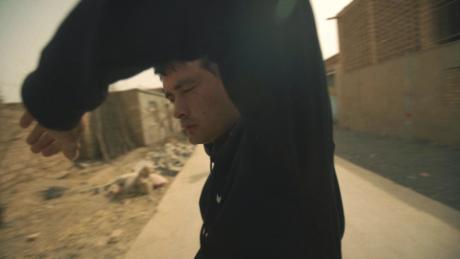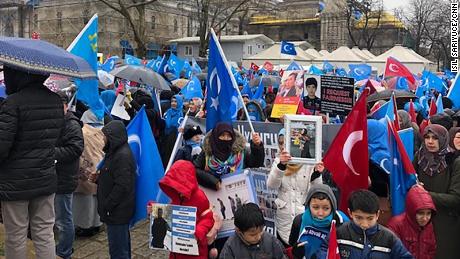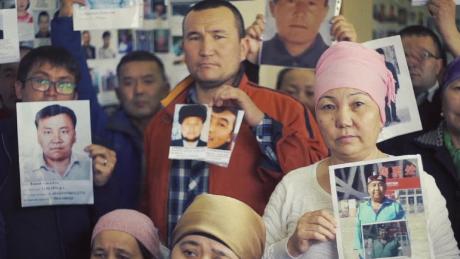Disturbing video shows hundreds of blindfolded prisoners in Xinjiang
A drone video appearing to show hundreds of blindfolded men being led from a train in China has raised new concerns over the ongoing crackdown on Muslim Uyghurs in the far western region of Xinjiang.
The video -- which was posted online anonymously last week -- shows hundreds of men, most of whom are dressed in purple and orange vests with the words "Kashgar Detention Center" printed on them, seated in rows on the ground of what appears to be a large courtyard outside a train station. Their heads are shaved and their hands bound behind their backs. All of the men are wearing black blindfolds over their eyes and they are being watched over by dozens of police officers in SWAT uniforms.
CNN cannot independently verify the authenticity of this video or the date it was shot. Chinese Foreign Ministry officials did not respond to repeated requests for comment on the video.
In a statement to CNN on October 4, authorities in Xinjiang said that "cracking down on crimes in accordance with law is the common practice of all countries."
"Xinjiang's crackdown on crimes has never been linked to ethnicities or religions," the statement added. "Transporting inmates by judicial authorities (is related) to normal judicial activities."
Prisoners in China are regularly transported wearing blindfolds. It is unclear whether the men are being held for criminal offenses or for other reasons. The YouTube account which uploaded the video described it as demonstrating the "long-term suppression of human rights and fundamental freedoms by the Chinese government in the Xinjiang Uygur Autonomous Region."
For the last two-and-a-half years, China has been detaining hundreds of thousands of Uyghurs and other predominantly Muslim ethnic minorities in what Beijing alternately describes as "voluntary de-radicalization camps" and "vocational training centers." Former detainees have described them as closer to internment camps, however, and allegations of abuse are rampant, including in firsthand accounts given to CNN describing torture and forced political re-education under the threat of violence.

CNN captures rare images China doesn't want you to see
Evidence points to Xinjiang
A western intelligence official told CNN they believed the video was authentic.
"China needs to be challenged for this behavior," the official said. "So many countries support China on human rights without understanding that it appears to be attempting to wipe out the entire Uyghur identity."
The official was able to verify the movement of some 500 prisoners earlier this year from Kashgar to Korla, information that broadly lined up with a separate analysis of the video by researcher Nathan Ruser, a China expert at the Australian Strategic Policy Institute. Ruser however suggests that the video was filmed in August 2018.
Ruser said that information in the video itself -- including data from the drone camera and visible landmarks that could be compared to open source satellite photos -- indicated that it had been recorded in Kuresi Station, near the city of Korla in central Xinjiang.
He added that the men in the video appeared to be being transported from a detention center in Kashgar "to the much more expansive Korla facilities."
A US official also told reporters on September 24 that Washington believes the video to be authentic. "Let's not talk about the validity of any particular evidence. It's the summary evidence, it's the bulk of evidence," State Department official David Stilwell said.
Chinese officials have not yet responded to the video. On September 23, Foreign Ministry spokeswoman Hua Chunying slammed US Secretary of State Mike Pompeo, who had said that China was attempting to "erase its own citizens" in Xinjiang and called on countries around the world to "resist China's demands to repatriate" Uyghurs.
Hua called Pompeo's statement "utterly defamatory and groundless," adding that Beijing urged relevant US officials to face the facts, be objective and fair, and not adopt double standards on counter-terrorism, let alone to use this as an excuse to launch unwarranted attacks against China," referring to Beijing's claims that activities in Xinjiang are about stemming a terrorist threat in the region.
While the US and several of its allies have been outspoken in condemning China's actions in Xinjiang, many nations in the Muslim world who do business with China have been more cautious in their statements. In July, nearly half the signatories of a letter defending Beijing's policies in the region were Muslim-majority nations, including Pakistan, Qatar, Syria, the United Arab Emirates and Saudi Arabia.

Uyghurs plead for answers about family in China
'That used to be me'
For two former detainees in Xinjiang, the video was strikingly familiar.
Amanzhan Seiit, a Muslim ethnic Kazakh, said he was detained in China in 2018, but was never told what for. After several weeks in one camp, he said he was moved to another in a fashion exactly the same as shown in the video.
"We were made to sit just like that," he told CNN. "They put cuffs on our hands and legs and masks over our heads. Lots of police were there with guns."
He was released after several months and now lives in Kazakhstan, a country on China's western border. While detained, he says the fear of not knowing what might happen was the worst.
"Watching the video, I'm still scared because I know what the prisoners are thinking," Seiit said. "They don't know where they're being taken or if they'll be shot dead. It's terrifying."
There are no publicly known instances of shooting deaths inside the camps. More than 3,000 miles away, Omerbek Bikali, another Muslim Kazakh, knows how it feels to be scared in custody.
He lives in the Netherlands now, after being detained in a Chinese camp for months in 2017. He claims he was tortured regularly and describes the camps as hell.
"I think the reason they want to torture us is, firstly, to make us physically weak so that you cannot resist," he said.
Bikali said though he was transferred between camps by car, he too had a bag placed over his head and his hands shackled. Watching the drone video, he was overcome with emotion.
"I feel so sad. That used to be me. I cannot forget that. It's criminal," he said.
Xinjiang authorities and Chinese Foreign Ministry officials did not respond to requests for comment about the former detainees' allegations.

The people affected by detention camps in China
Restricted region
Beijing has had a long and fractious history with Xinjiang, a massive, nominally autonomous region in the far west of the country that is home to approximately 22 million of the about 1.4 billion people living in China.
The predominantly Muslim Uyghurs are ethnically distinct from the country's majority ethnic group, the Han Chinese. The Uyghurs form the majority in Xinjiang, where they account for just under half of the total population. Some Uyghurs claim the camps are part of a "cultural genocide" by Beijing, to eliminate the Uyghurs' religion and culture and bring them closer to China's majority Han population.
Speaking to reporters in July, Shohrat Zakir, Xinjiang's governor and the region's highest-ranking ethnic Uyghur official, said that most detainees have been released, adding that the camps have been "hugely positive" for the region.
He declined to answer a question as to how many people remained in the camps.
Zakir said the camps had taught Uyghurs to practice their religion "normally" but added no single religion or minority group had been targeted.
"If there still skeptics, whether they are journalists, officials or religious figures, we welcome them to visit anywhere in Xinjiang or go to any vocational training center of their choice -- anytime," he said.
Previous attempts by CNN to visit the internment camps have been repeatedly blocked by local authorities.
News Courtesy: www.cnn.com











